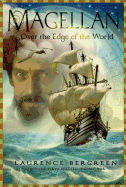
Although the Strait of Magellan is marked on modern maps, many readers may not be familiar with the Portuguese explorer for whom the Strait is named. Setting out in 1519 with five ships and more than 200 sailors, Fernão de Magalhães (known in English as Ferdinand Magellan) sailed for Spain in an attempt to find the Spice Islands (an archipelago in present-day Indonesia). Magellan was an ambitious man who bristled at sharing power with his fellow captains, ruthlessly drove his sailors (sometimes unnecessarily cutting their rations) and mistreated the indigenous communities along his route, often trying to convert people to Christianity. He survived vicious mutinies only to find death in the Philippines--before his mission was accomplished--by needlessly interfering in a local conflict.
Laurence Bergreen, a prolific biographer (Columbus: The Four Voyages, 1492-1504; Marco Polo: From Venice to Xanadu), has ably adapted Magellan: Over the Edge of the World from his adult book, Over the Edge of the World. Bergreen tells the story of the Armada de Molucca, at first focusing on Magellan--his good decisions and his bad--but then describing the fates of the other boats, captains and men, revealing that only one boat and 18 men returned to Seville after the full circumnavigation. He details shocking shipboard conditions, such as food contaminated by weevils and rat urine and the prevalence of scurvy caused by the lack of vitamin C and medical knowledge. Excerpts from the journal kept by Antonio Pigafetta, a Venetian scholar who survived the expedition, appear throughout the book and some of the archival illustrations are also from Pigafetta's work. Excellent chapter notes, an extensive bibliography and maps are included. --Melinda Greenblatt, freelance book reviewer

